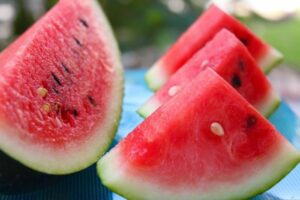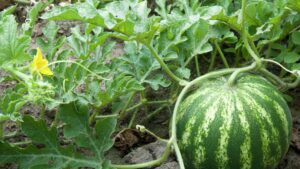Is watermelon a vegetable? This seemingly simple question has sparked debates for centuries, as the answer lies not only in culinary traditions but also in the realm of botanical science. Join us on an intriguing journey to uncover the truth behind this enigmatic fruit.
From its classification to its nutritional value, we will explore the fascinating world of watermelon, revealing its unique characteristics and cultural significance. Along the way, we will discover whether this juicy summer staple deserves a place among the vegetables or reigns supreme as a fruit.
Botanical Classification

Watermelon’s scientific classification places it within the plant kingdom, under the division Magnoliophyta, class Magnoliopsida, order Cucurbitales, and family Cucurbitaceae. This family encompasses various fruits, including cucumbers, squash, pumpkins, and gourds.
Botanically, fruits are the ripened ovaries of flowering plants that contain seeds. Vegetables, on the other hand, are the edible parts of plants, such as roots, stems, leaves, or flowers. While the culinary world often classifies watermelon as a vegetable due to its savory taste, scientifically, it is a fruit.
Examples of Other Fruits and Vegetables with Similar Classifications
- Tomatoes, despite their culinary use as vegetables, are botanically classified as fruits due to their seed-bearing ovaries.
- Cucumbers, like watermelon, belong to the Cucurbitaceae family and are scientifically classified as fruits.
- Rhubarb, commonly used in desserts, is botanically a vegetable as it is derived from the stems of the plant.
- Broccoli, cauliflower, and artichokes are all vegetables as they are edible flower buds or immature inflorescences.
Culinary Usage
Watermelon, with its refreshing and juicy flesh, is a versatile ingredient that lends itself to a wide range of culinary applications. Its sweet and thirst-quenching qualities make it a popular choice for summer salads, desserts, and beverages.
Salads
In salads, watermelon adds a burst of color and flavor, complementing both sweet and savory ingredients. It can be diced and tossed with arugula, feta cheese, and a balsamic vinaigrette for a refreshing summer salad. Alternatively, it can be grilled and added to a salad with grilled halloumi, quinoa, and a honey-mustard dressing.
Desserts
Watermelon’s natural sweetness makes it an excellent base for desserts. It can be blended into sorbets, granitas, and ice creams for a refreshing treat. Additionally, watermelon can be used to make fruit tarts, pies, and cobblers, providing a juicy and flavorful filling.
Beverages
Watermelon’s high water content and refreshing flavor make it a perfect ingredient for beverages. It can be juiced and enjoyed as a refreshing drink on its own or mixed with other fruits and vegetables for a smoothie. Additionally, watermelon can be infused into cocktails and mocktails, adding a touch of sweetness and summery flavor.
Nutritional Value
Watermelon is a nutritional powerhouse, brimming with an array of vitamins, minerals, and antioxidants. Its impressive nutrient profile sets it apart from many other fruits and vegetables.
Watermelon is an excellent source of vitamin C, a vital antioxidant that helps protect the body against free radical damage. It also contains significant amounts of vitamin A, essential for maintaining healthy vision and skin. Furthermore, watermelon is rich in potassium, an essential mineral for regulating blood pressure and fluid balance.
Antioxidant Content
Watermelon is a treasure trove of antioxidants, including lycopene, beta-carotene, and vitamin C. Lycopene, a potent antioxidant, has been linked to reduced risk of chronic diseases such as heart disease and certain types of cancer.
Comparison to Other Fruits and Vegetables, Is watermelon a vegetable
Compared to other fruits and vegetables, watermelon stands out for its high water content, which makes it a refreshing and hydrating snack. It is also a good source of vitamins and minerals, with a nutrient profile similar to that of cantaloupe and honeydew melon. However, watermelon has a lower sugar content than many other fruits, making it a healthier choice for those seeking a nutritious and refreshing treat.
Cultural Significance

The watermelon, with its juicy red flesh and refreshing taste, has carved a niche in the cultural fabric of many regions worldwide. Its historical and symbolic associations add to its culinary appeal, making it a fruit steeped in tradition and meaning.
Ancient Origins
Watermelon’s origins can be traced back to ancient Egypt, where it was cultivated as early as 2000 BC. Paintings and hieroglyphics depict pharaohs and nobles enjoying this sweet fruit, suggesting its high status and cultural significance. In ancient Greece, watermelons were known as “sikos” and were considered a symbol of fertility and abundance.
Symbolism and Traditions
In many cultures, watermelon holds symbolic meanings. In China, it represents prosperity and good fortune, often used as a decorative element during festivals and celebrations. In Japan, it symbolizes summer and is a popular treat during Obon, a festival honoring the spirits of ancestors.
Cultural Anecdotes
Watermelon has played a significant role in various historical events and anecdotes. During the American Civil War, Union soldiers were known to have carried watermelons as a source of hydration and morale booster. In the 1960s, watermelon became a symbol of the civil rights movement, as African Americans were often denied access to public pools and other cooling facilities during the hot summer months.
Varieties and Cultivation

Watermelons come in a wide range of varieties, each with its own unique characteristics. Some of the most popular varieties include:
- Seedless Watermelon: As the name suggests, these watermelons have no seeds, making them easy to eat and enjoy. They are typically sweeter and have a thinner rind than seeded varieties.
- Seeded Watermelon: These watermelons contain black or brown seeds and have a thicker rind. They are known for their intense flavor and are often used in salads, desserts, and other dishes.
- Yellow Watermelon: These watermelons have a yellow or orange flesh and a sweeter taste than traditional red watermelons. They are a good source of vitamin C and potassium.
- Moon and Stars Watermelon: This variety has a dark green rind with yellow spots, resembling a night sky. It has a sweet and juicy flesh.
- Crimson Sweet Watermelon: This variety is known for its large size, bright red flesh, and sweet flavor. It is a popular choice for picnics and barbecues.
Growing Conditions
Watermelons are warm-season crops that require plenty of sunlight and well-drained soil. They can be grown in both temperate and tropical climates.
- Temperature: Watermelons prefer temperatures between 70-85°F (21-29°C) for optimal growth.
- Soil: Watermelons thrive in sandy or loamy soil with a pH between 6.0 and 6.5. The soil should be well-drained to prevent waterlogging.
- Sunlight: Watermelons require at least 6 hours of direct sunlight per day.
Cultivation Methods
Watermelons can be grown from seeds or transplants. If starting from seeds, sow them indoors 4-6 weeks before the last frost. Transplant seedlings outdoors when they have developed 2-3 true leaves.
- Spacing: Space watermelon plants 3-4 feet apart to allow for proper growth and air circulation.
- Watering: Watermelons need regular watering, especially during hot, dry weather. Water deeply and infrequently, allowing the soil to dry out slightly between waterings.
- Fertilizing: Fertilize watermelon plants every 3-4 weeks with a balanced fertilizer.
Harvesting Techniques
Watermelons are ready to harvest when the rind turns dull and the underside of the melon turns yellow. To harvest, cut the watermelon from the vine with a sharp knife.
Selection and Storage
When selecting a watermelon, look for one that is symmetrical in shape and has a smooth, unblemished rind. Avoid watermelons with soft spots or cracks.
- Storage: Store watermelons at room temperature for up to a week. For longer storage, place them in the refrigerator for up to 2 weeks.
Epilogue
In conclusion, the botanical classification of watermelon firmly places it in the fruit category, despite its common usage as a vegetable in culinary preparations. Its nutritional richness and cultural significance further solidify its status as a fruit. So, next time you indulge in a refreshing slice of watermelon, remember that you are not only enjoying a delicious treat but also partaking in a piece of botanical history.
User Queries: Is Watermelon A Vegetable
Is watermelon a fruit or a vegetable?
Botanically speaking, watermelon is a fruit, as it is the ripened ovary of a flowering plant and contains seeds.
What is the difference between a fruit and a vegetable?
In botany, fruits are the mature ovaries of plants that contain seeds, while vegetables are the edible parts of plants, such as roots, stems, or leaves.
What are the nutritional benefits of watermelon?
Watermelon is rich in vitamins A, C, and B6, as well as minerals like potassium and magnesium. It is also a good source of antioxidants.







Leave a Comment